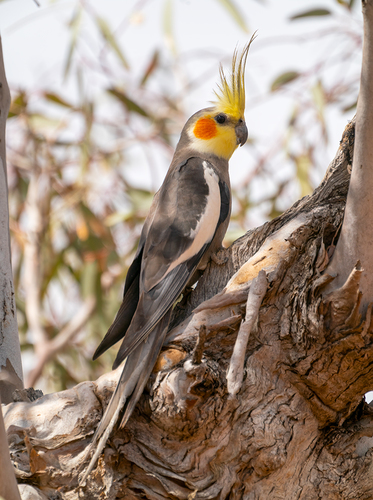
Cockatiel
The Cockatiel (*Nymphicus hollandicus*) is a small, crested parrot native to Australia, renowned for its distinctive appearance and amiable personality. These birds play a crucial role in their native ecosystems as seed dispersers, contributing to the health and diversity of Australian flora. Beyond their ecological importance, Cockatiels hold a unique position as one of the world's most popular companion birds, beloved for their gentle nature, trainability, and ability to mimic sounds. They are not considered culturally significant in the same way as some other Australian parrots, but their popularity has made them iconic.
30-33 cm
Length
Not Evaluated cm
Wingspan
Least Concern
Conservation Status
Distribution
Endemic to Australia, found throughout the mainland, particularly in the arid and semi-arid interior. They are less common in the far north, coastal regions, and Tasmania. No significant migratory routes are observed, though they are nomadic, moving in response to food and water availability.
Lifespan
10-14 years in the wild; 15-20 years or more in captivity with proper care.
Cockatiel's Habitat
Habitat Types
Open woodlands, Savannas, Shrublands, Grasslands, Agricultural areas (near water)
Climate Zones
Arid, Semi-arid, Temperate (inland)
Adaptations
Cockatiels are well-adapted to dry conditions, capable of surviving on limited water sources and utilizing a variety of seeds and vegetation. Their nomadic behavior allows them to exploit ephemeral resources.
Variations
No recognized subspecies exist, but there can be slight regional variations in plumage color and intensity.
Appearance
Breeding Plumage
No significant difference between breeding and non-breeding plumage.
Seasonal Feather Changes
No seasonal variations.
Sex Based Plumage Differences
Males typically have brighter yellow faces and crests, and more defined orange cheek patches. Females have barring on the underside of their tail feathers, which is absent or less pronounced in males.
Notable Features
Erectile crest (expresses mood), Orange cheek patches, Long, pointed tail feathers, Grey body plumage (in the wild type)
Diet and Feeding
Primary Foods
Seeds (grasses, crops), Grains, Fruits (occasionally), Vegetation (leaf buds, etc.)
Foraging Behavior
Cockatiels primarily forage on the ground, often in large flocks. They use their beaks and feet to manipulate seeds and extract them from seed heads.
Specializations
Their strong beaks are adapted for cracking open seeds. They also have a zygodactyl foot arrangement (two toes pointing forward, two backward) which aids in grasping and manipulating food.
Seasonal Diet Variations
Diet varies depending on the availability of seeds and other food sources throughout the year. During periods of drought, they may rely more on hardy seeds and vegetation.
Behavior
Social Structure
Highly social birds, often found in large flocks, especially outside of the breeding season. Pairs form strong bonds and often remain together year-round.
Communication
Vocalizations (whistles, calls, songs), Crest position (signaling mood), Body postures (head bobbing, wing flicking)
Migration
Cockatiels are not truly migratory, but they are nomadic, moving locally and regionally in response to food and water availability.
Territorial or Group Behaviors
During the breeding season, pairs become territorial and defend their nesting site. Outside of breeding, they are highly social and form large flocks.
Conservation
Threats
Habitat loss (due to agriculture and land clearing), Trapping for the pet trade (historically, now largely regulated), Competition with introduced species
Protection Programs
CITES Appendix II (regulates international trade), Protected under Australian wildlife legislation
Local National Laws
Protected under various state and national laws in Australia, requiring permits for keeping and trading.
Population Trend
Stable
Population Estimates
While precise population estimates are difficult, the species is considered abundant and widespread.
Interesting Facts
Cockatiels are the smallest members of the cockatoo family.
This distinguishes them from larger cockatoo species.
They can mimic sounds and human speech.
Although not as proficient as some other parrots, they can learn words and phrases, especially males.
The crest position indicates the bird's mood.
A raised crest signifies excitement or alarm, while a flattened crest indicates relaxation or fear.
They are known for their 'powder down' feathers.
These specialized feathers produce a fine powder that helps waterproof and clean their plumage.
Cockatiels are among the most popular pet birds globally
These birds are known for their gentle nature, trainability, and ability to mimic sounds.
Faqs about Cockatiel
Are Cockatiels good pets?
Cockatiels can make excellent pets for responsible owners. They are relatively quiet, affectionate, and enjoy interaction. However, they require daily care, attention, and a suitable environment.
Can Cockatiels talk?
Yes, Cockatiels can learn to mimic words and phrases, although their vocabulary is typically smaller than that of some other parrot species. Males are generally more vocal than females.
What do Cockatiels eat?
In the wild, Cockatiels eat a variety of seeds, grains, fruits, and vegetation. Pet Cockatiels should be fed a balanced diet consisting of high-quality seed mixes, pellets, fresh fruits, and vegetables. Consult a professional for diet advice.
How long do Cockatiels live?
In the wild, Cockatiels typically live for 10-14 years. In captivity, with proper care, they can live for 15-20 years or even longer.
Do Cockatiels need a lot of space?
Cockatiels are active birds and require a spacious cage that allows them to move around, climb, and spread their wings. They also benefit from out-of-cage time in a safe, supervised environment.
Copyright @ Nature Style Limited. All Rights Reserved.
 English
English